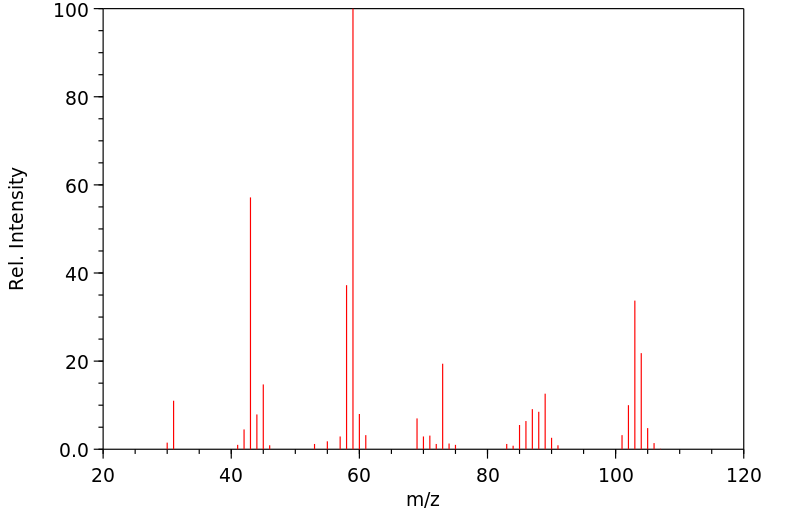1,1,2-三甲基二硅烷 | 814-74-4
中文名称
1,1,2-三甲基二硅烷
中文别名
——
英文名称
1,1,2-Trimethyl-disilan
英文别名
1,1,2-Trimethyldisilan;1,1,2-Trimethyldisilane;dimethyl(methylsilyl)silane
CAS
814-74-4
化学式
C3H12Si2
mdl
——
分子量
104.299
InChiKey
JDTCYQUMKGXSMX-UHFFFAOYSA-N
BEILSTEIN
——
EINECS
——
-
物化性质
-
计算性质
-
ADMET
-
安全信息
-
SDS
-
制备方法与用途
-
上下游信息
-
文献信息
-
表征谱图
-
同类化合物
-
相关功能分类
-
相关结构分类
物化性质
-
沸点:67-86°C
-
密度:0,7 g/cm3
-
闪点:-17°C
计算性质
-
辛醇/水分配系数(LogP):0.19
-
重原子数:5
-
可旋转键数:1
-
环数:0.0
-
sp3杂化的碳原子比例:1.0
-
拓扑面积:0
-
氢给体数:0
-
氢受体数:0
安全信息
-
危险类别码:R38,R12,R20
-
安全说明:S16,S23,S26,S28,S36
SDS
上下游信息
-
上游原料
中文名称 英文名称 CAS号 化学式 分子量 1,1,2,2-四甲基乙硅烷 1,1,2,2-tetramethyldisilane 814-98-2 C4H14Si2 118.326 -
下游产品
中文名称 英文名称 CAS号 化学式 分子量 1,2-二甲基二硅烷 1,2-dimethyldisilane 870-26-8 C2H10Si2 90.2724
反应信息
-
作为反应物:描述:参考文献:名称:INOUEH, KAORU;MIYAGAVA, XIRODZI;ITO, MASAESI;ABEH, TOMOXARU;KOIDZUMI, KEG+摘要:DOI:
-
作为产物:描述:参考文献:名称:Chemistry of atomic silicon. III. Reactions of electron bombardment produced silicon vapor with silanes摘要:DOI:10.1021/ja00770a046
文献信息
-
Time-resolved studies of the temperature dependence of the gas-phase reactions of methylsilylene with silane and the methylsilanes作者:Rosa Becerra、H. Monty Frey、Ben P. Mason、Robin WalshDOI:10.1039/ft9938900411日期:——initio theory (for the reaction of SiH2 with SiH4) these show that the electrophilic interaction probably precedes the nucleophilic interaction, although the latter is important in the rate-determining (second) step for the insertion reactions of both MeSiH and SiMe2. Combination of MeSiH insertion rate constants with the reverse unimolecular decomposition rate constants of the product disilanes enable the业已发现,气相1,2-二甲基乙硅烷的193 nm激光闪光光解能在454-515 nm波长范围内提供宽带吸收,这可能是由于瞬态物质甲基亚甲硅烷基MeSiH所致。通过进行标题研究,对MeSiH进行了首次直接动力学研究,获得了MeSiH与SiH 4,MeSiH 3,Me 2 SiH 2和Me 3 SiH在温度范围为360-580的反应的二级速率常数。K.反应很快,但显示出负活化能,从SiH 4的–7.5 kJ mol –1增加到Me 3的–18.4 kJ mol –1。SiH。数据被解释为是通过一个中间复合物进行的,该中间复合物的重排在较高温度下决定了速率。MeSiH与其他甲硅烷基的反应活性的比较揭示了这些配合物的甲基取代基作用的一般模式。结合从头算理论(对于SiH 2与SiH 4的反应),这些表明亲电相互作用可能先于亲核相互作用,尽管后者在速率确定(第二步)对于两个MeSiH的插入反应均很重要和SiMe
-
Disilane Cleavage with Selected Alkali and Alkaline Earth Metal Salts作者:Tobias Santowski、Alexander G. Sturm、Kenrick M. Lewis、Thorsten Felder、Max C. Holthausen、Norbert AunerDOI:10.1002/chem.201902722日期:2019.10.11production chain. In this work, disilane cleavage by using alkali and alkaline earth metal salts is reported. The reaction with metal hydrides, in particular lithium hydride (LiH), leads to efficient reduction of chlorine containing disilanes but also induces disproportionation into mono‐ and oligosilanes. Alkali and alkaline earth chlorides, formed in the course of the reduction, specifically induce
-
Hydrierung von Silicium-Halogen-Verbindungen mittels Trialkylstannylchlorid/Natriumhydrid作者:E. Hengge、C. Grogger、F. Uhlig、G. Roewer、U. Herzog、U. P�tzoldDOI:10.1007/bf00807428日期:1995.5Organotinchlorides of the general formula R(3)SnCl and R(2)SnCl(2) (R = Me, n-Bu, Ph) can easily be converted into the corresponding hydrides R(3)SiH and R(2)SiH(2) employing NaH in diethylene glycol dialkyl ethers. Using trialkyltinhydrides like Bu,SnH in combination with a catalyst (tertiary amines, N-heterocycles, phosphonium or ammonium salts), Si-Cl bonds in mono- and disilanes are hydrogenated. In the case of disilanes, Si-Si bond cleavage and concurrent hydrogenation can be afforded with strongly nucleophilic catalysts. Partial hydrogenation is also possible. The whole process can be run cyclically.
表征谱图
-
氢谱1HNMR
-
质谱MS
-
碳谱13CNMR
-
红外IR
-
拉曼Raman
-
峰位数据
-
峰位匹配
-
表征信息
同类化合物
(2-溴乙氧基)-特丁基二甲基硅烷
鲸蜡基聚二甲基硅氧烷
骨化醇杂质DCP
马沙骨化醇中间体
马来酸双(三甲硅烷)酯
顺式-二氯二(二甲基硒醚)铂(II)
顺-N-(1-(2-乙氧基乙基)-3-甲基-4-哌啶基)-N-苯基苯酰胺
降钙素杂质13
降冰片烯基乙基三甲氧基硅烷
降冰片烯基乙基-POSS
间-氨基苯基三甲氧基硅烷
镓,二(1,1-二甲基乙基)甲基-
镁,氯[[二甲基(1-甲基乙氧基)甲硅烷基]甲基]-
锑,二溴三丁基-
铷,[三(三甲基甲硅烷基)甲基]-
铂(0)-1,3-二乙烯-1,1,3,3-四甲基二硅氧烷
钾(4-{[二甲基(2-甲基-2-丙基)硅烷基]氧基}-1-丁炔-1-基)(三氟)硼酸酯(1-)
金刚烷基乙基三氯硅烷
酰氧基丙基双封头
达格列净杂质
辛醛,8-[[(1,1-二甲基乙基)二甲基甲硅烷基]氧代]-
辛甲基-1,4-二氧杂-2,3,5,6-四硅杂环己烷
辛基铵甲烷砷酸盐
辛基衍生化硅胶(C8)ZORBAX?LP100/40C8
辛基硅三醇
辛基甲基二乙氧基硅烷
辛基三甲氧基硅烷
辛基三氯硅烷
辛基(三苯基)硅烷
辛乙基三硅氧烷
路易氏剂-3
路易氏剂-2
路易士剂
试剂Cyanomethyl[3-(trimethoxysilyl)propyl]trithiocarbonate
试剂3-[Tris(trimethylsiloxy)silyl]propylvinylcarbamate
试剂3-(Trimethoxysilyl)propylvinylcarbamate
试剂2-(Trimethylsilyl)cyclopent-2-en-1-one
试剂11-Azidoundecyltriethoxysilane
西甲硅油杂质14
衣康酸二(三甲基硅基)酯
苯胺,4-[2-(三乙氧基甲硅烷基)乙基]-
苯磺酸,羟基-,盐,单钠聚合甲醛,1,3,5-三嗪-2,4,6-三胺和脲
苯甲醇,a-[(三苯代甲硅烷基)甲基]-
苯并磷杂硅杂英,5,10-二氢-10,10-二甲基-5-苯基-
苯基二甲基氯硅烷
苯基二甲基乙氧基硅
苯基二甲基(2'-甲氧基乙氧基)硅烷
苯基乙酰氧基三甲基硅烷
苯基三辛基硅烷
苯基三甲氧基硅烷







